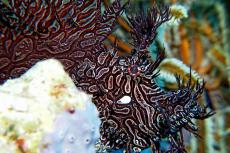Tufi, New Ireland & Milne Bay
Is there another country anywhere with so much diversity? The six million inhabitants of this nation of mountains and islands are spread over 463,000km2 of mountainous tropical forests and speak over 800 different languages (12 percent of the world total). Papua New Guinea occupies half of the third largest island in the world as well as 160 other islands and 500 named cays.
Tags & Taxonomy
Located just south of the Equator and to the north of Australia, Papua New Guinea (PNG) is a diver’s paradise with the fourth largest surface area of coral reef ecosystem in the world (40,000km2 of reefs, seagrass beds and mangroves in 250,000km2 of seas), and underwater diversity with 2,500 species of fish, corals and molluscs.
There are more dive sites than you can shake a stick at with many more to be discovered and barely a diver on them. The dive centres are so far apart that there is only ever one boat at any dive site.
It is one of the few places left in the world where a diver can see macro critters, pelagics and big stuff as well as fantastic soft and hard corals. The often misused and abused adjective, ‘pristine’, is actually appropriate here due to low fishing pressure in the area in comparison to other areas of the Coral Triangle, no dynamite fishing and a system implemented by dive resorts whereby local reef owners receive a small fee for every diver who visit their reef. As a result, elders make sure that the reefs are not fished.
So, where to go? We set off on a four-resort tour to the north and the south taking in the provinces of Milne Bay, Oro and New Ireland.
Tufi
Sitting at the back of the De Havilland Twin Otter with my partner, Imi, and an American Mom-Dad-and-teenage-son-combo in front, I peered through the misty clouds at the swath of trees below, occasionally cut by the hairline crack of a path or the meandering swirls of a river.
The jagged peaks of the Owen-Stanley range that run down the spine of the island weren’t that far away, as we headed east from Port Moresby to Tufi. The landscape was rugged to say the least, and it was easy to understand why both Australian and Japanese troops had struggled during the Second World War battles there.
As we approached the east coast of Oro Province, the spectacular fjords of Cape Nelson came into view—a strange mix of glacial action now topped by lush tropical forest, with aqua coral reefs surrounding the headlands clearly visible in the cobalt blue of the Solomon Sea. Banking steeply, we lined up with the gravel airstrip and touched down. Two 4WD vehicles were waiting for us to take us on the one-minute drive to the resort.
With a fruit juice in hand, we whizzed through the usual paperwork and were asked to leave our dive gear outside our rooms in 20 minutes and meet at the reception area from where we were taken down to the dive centre. Less than 90 minutes after landing, the five of us plus instructor Glen and dive master Alex were in a boat and heading off across the flat sea to Bev’s Reef—part of the mid-distance reef system and one of the several Tufi reefs with a manta cleaning station. Using a well-drawn dive site map, Glen laid out the plan for a drift dive, and off we went. ....
(...)




































